Table of Contents
What is an Analytical Paragraph Writing?
An analytical paragraph is a key element in academic writing, especially for students in class 10. This type of paragraph involves dissecting a topic to understand its various components. Analytical paragraph class 10 focuses on teaching students to structure their analysis coherently. When learning how to write an analytical paragraph, students must focus on clarity and precision.
Analytical paragraph class 10 examples and analytical paragraph class 10 solved examples pdf are valuable resources for understanding this format. These examples often include tasks like writing an analytical paragraph on a bar graph or an analytical paragraph pie chart, which are common in analytical paragraph class 10 CBSE syllabus.
The analytical paragraph class 10 format typically includes an introduction, evidence or examples, and a conclusion. This paragraph writing format is essential for students to articulate their thoughts clearly.
For diverse educational contexts, resources like analytical paragraph kaise likhen provide region-specific guidance. Additionally, analytical paragraph class 10 questions and analytical paragraph class 10 worksheet are useful tools for exam preparation.
Overall, mastering the analytical paragraph format is crucial for students in class 10th, as it enhances their critical thinking and writing skills.
Types of Analytical Paragraphs
In educational settings, particularly in analytical paragraph class 10, students are introduced to various types. For instance, an analytical paragraph on a bar graph or an analytical paragraph pie chart are common types where students analyze graphical data. These forms are integral to the analytical paragraph class 10 CBSE curriculum.
- Text Analysis: This type of analytical paragraph involves dissecting a piece of writing, such as a poem, story, or article. Students analyze elements like theme, character development, or author’s intent. For example, in analytical paragraph class 10, students might explore the symbolism in a poem or the argument in an editorial.
- Graphical Data Analysis: This includes analytical paragraphs on bar graphs and analytical paragraphs on pie charts. Students interpret and discuss the data presented in these graphical forms. In analytical paragraph class 10 CBSE, such assignments help students learn to derive and articulate insights from visual data.
- Literary Analysis: Common in class 10 analytical paragraph, this type requires students to delve into literature, examining aspects like plot, setting, and literary devices. Analytical paragraph class 10 solved examples often include analyses of famous literary works.
- Historical Analysis: Here, students analyze historical events or periods. This type of paragraph might discuss causes and effects of an event or compare different historical periods. It’s a common assignment in analytical paragraph class 8 and analytical paragraph class 9.
- Scientific Analysis: Involving the examination of scientific concepts or experiments, this type of analytical paragraph is often found in science subjects. Students might analyze a scientific theory or the results of an experiment.
- Persuasive Analysis: This involves analyzing persuasive texts or speeches, focusing on techniques used to persuade the audience. It’s a key skill developed in analytical paragraph writing.
Each type of analytical paragraph requires a specific approach but follows a general analytical paragraph format. Understanding these types is crucial for students, especially in class 10th, as they provide a foundation for critical thinking and effective communication.
How to Write an Analytical Paragraph?
To write an analytical paragraph, it’s essential to understand its structure and purpose. An analytical paragraph focuses on breaking down a topic into its key elements and discussing each one in detail. This type of paragraph is especially important in educational settings, such as in class 10, where students are often required to analyze texts, data, or graphs.
Here’s a step-by-step guide to how to write an analytical paragraph:
- Introduction: Start your paragraph with a clear topic sentence. This sets the stage for your analysis. For example, in a class 10 analytical paragraph, you might introduce a theme from a novel or a trend shown in a graph.
- Evidence and Analysis: Include specific examples or data to support your topic. This could be quotes from a text in analytical paragraph class 10 CBSE or data points from an analytical paragraph on bar graph. Explain how these examples support your main point.
- Explanation: Elaborate on how your evidence relates to your topic. This is where you analyze the evidence and show your understanding. In class 10th, this part is crucial to demonstrate your analytical skills.
- Conclusion: End with a statement that summarizes your analysis and ties it back to your topic sentence.
For more guidance, students can refer to analytical paragraph class 10 solved examples or analytical paragraph class 10 solved examples pdf. These resources provide practical examples that follow the analytical paragraph format and paragraph writing format.
Analytical Paragraph Format
The analytical paragraph format is a structured approach to writing that focuses on breaking down a topic to understand and explain its various components. For practical understanding, analytical paragraph class 10 solved examples and analytical paragraph class 10 solved examples pdf are excellent resources. These examples show class 10 analytical paragraph in action, often including tasks like writing an analytical paragraph on a bar graph or an analytical paragraph pie chart, as found in the analytical paragraph class 10 CBSE syllabus.
Analytical Paragraph Class 10 Format
- Introduction: Begin with a clear statement of the topic or argument. This sets the stage for the analysis.
- Body:
- Present your analysis of the topic.
- Include evidence or examples to support your points.
- This may involve discussing data from sources like texts, bar graphs, or pie charts, especially in the context of analytical paragraph class 10.
- Conclusion:
- Summarize your analysis.
- Tie back to the introduction and restate the main point or argument.
Features of an Analytical Paragraph
- Structure and Clarity: An analytical paragraph should have a clear structure. This includes an introduction, body, and conclusion. The analytical paragraph format ensures that the analysis is coherent and easy to follow.
- Focused Analysis: In analytical paragraph writing, the focus is on breaking down a subject into its essential elements. This is especially evident in class 10 analytical paragraph, where students analyze texts or data like in analytical paragraph on bar graph.
- Evidence-Based: A hallmark of a good analytical paragraph example is the use of evidence or examples to support the analysis. Analytical paragraph class 10 solved examples often demonstrate how to effectively use evidence in your writing.
- Relevance to Topic: Everything written in the paragraph should be relevant to the main topic. In class 10 analytical paragraph, for example, students learn to stay focused on the topic, whether they’re answering analytical paragraph class 10 questions or analyzing a pie chart.
- Logical Progression: The ideas in an analytical paragraph should flow logically. This is a key aspect of how to write an analytical paragraph and is emphasized in analytical paragraph class 10 CBSE.
- Conciseness: The paragraph should be concise and to the point, avoiding unnecessary details. This is evident in the analytical paragraph class 10 format, where brevity is valued.
- Appropriate for Audience: The language and style should be suitable for the intended audience. For younger students like in class 8 and class 9, the language is simpler compared to class 10th.
- Educational Resources: There are many resources available for learning and practice, such as analytical paragraph class 10 worksheet, analytical paragraph class 10 solved examples pdf, and guides like analytical paragraph kaise likhen for diverse learning contexts.

Analytical Paragraph Example
For students seeking guidance, analytical paragraph class 10 solved examples or analytical paragraph class 10 solved examples pdf can be excellent for class 10 CBSE students requirements and help in understanding the format. Here are more than 10 examples of analytical paragraph for class 10
Analytical Paragraph Class 10 Solved Examples
Below we have discussed analytical paragraph solved examples for class 10 students
Eg: 1 The pie chart shows the proportion of people from different households living in poverty in the UK in 2002. Write an analytical paragraph to describe the information in 100-120 words.
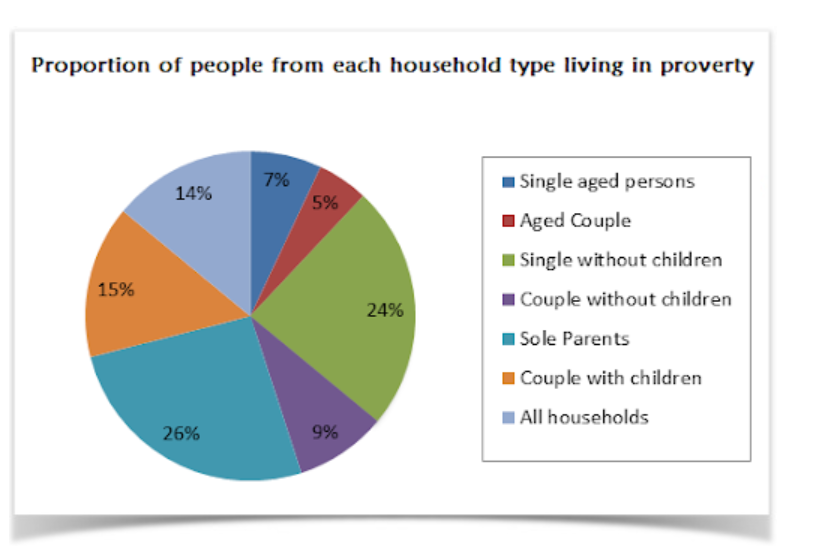
Answer: The pie chart provides a clear depiction of poverty distribution among different household types in the UK in 2002. Notably, single-parent households represent 26% of all poverty-affected families, marking them as the most vulnerable group. Following closely are single individuals without children, making up 24% of the impoverished households. This contrasts sharply with couples without children, who constitute a smaller segment at 9%, while families with children make up 15% of the poverty demographic. Additionally, single elderly individuals and elderly couples together account for 12% of households in poverty.
Eg: 2 The given line graph provides information about changes in birth and death rates in New Zealand between 1901 and 2101. Write an analytical paragraph summarizing the information and make comparisons where relevant in about 100-120 words.
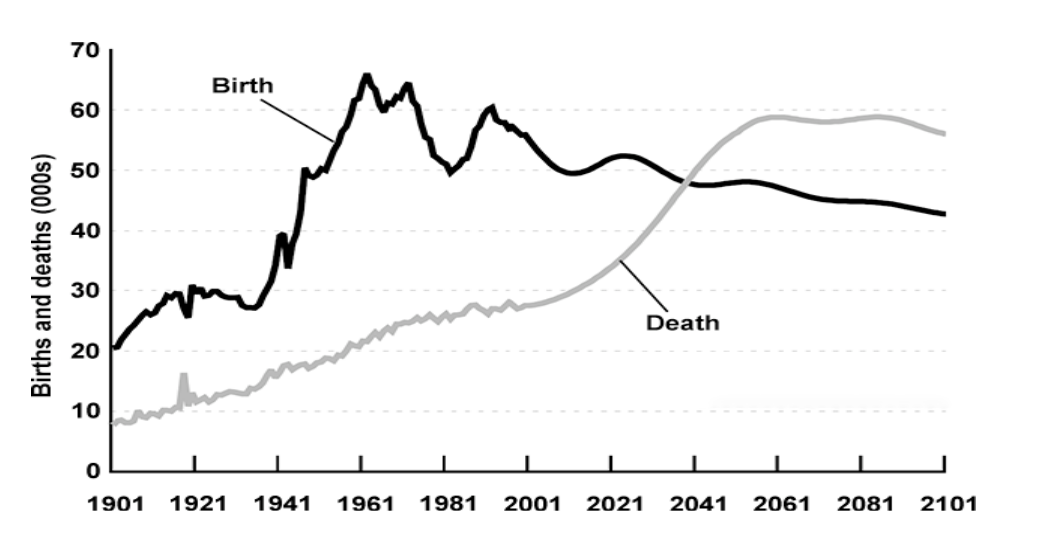
Answer: The line graph outlines the trajectory of birth and death rates in New Zealand from 1901 and projects trends up to 2101. Initially, the birth rate was substantially higher than the death rate, beginning at 20,000 in 1901 and peaking near 65,000 in 1961. After the peak, birth rates have seen ups and downs but remained within the 50,000 to 60,000 range. A notable decline in births is anticipated, dropping to about 42,000 by 2101. The death rate, in contrast, started around 10,000 in 1901 and has shown a steady rise. A significant surge in death rates is predicted post-2021, stabilizing around 60,000 between 2061 and 2081, with a slight decrease by 2101. The earlier wide gap between births and deaths is expected to narrow significantly, leading to an unprecedented shift where deaths may surpass births towards the end of the century.
Below is the list of all other paragraph on different topics available at IL
Analytical Paragraph Class 10 Questions
Below discussed questions is from analytical paragraph class 10 PYQ which will help you to prepare for your class 10 CBSE exam.
Q.1 The graph given shows estimated sales of gold in Dubai in 2002. Write an analytical paragraph describing the line graph in around 150 words.
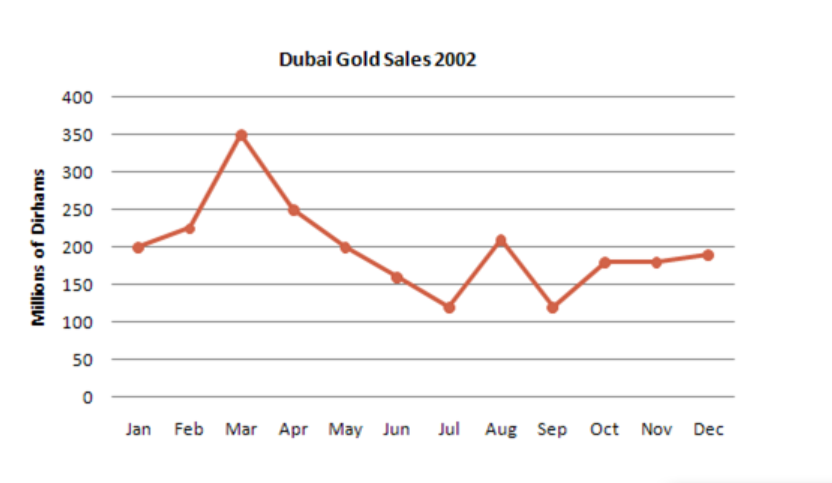
Answer: The line graph presents an analysis of gold sales in Dubai over the course of 2002, measured in millions of Dirhams. The year opened with sales at around 200 million Dirhams and displayed a rising trend, reaching a crest at 350 million Dirhams by March. This peak signifies a robust period for the gold market in Dubai. Subsequently, a decline was observed, with sales dipping to a low of 110 million Dirhams by July, illustrating a sharp fall in the market. Interestingly, there was a significant rebound in August, where sales momentarily doubled, only to fall back to the July figures in September. The remainder of the year saw the sales stabilize at 180 million Dirhams before a modest uptick in December.
Overall, the graph indicates a volatile year for the gold industry in Dubai, with peaks and troughs aligning with various economic factors or seasonal trends. The highest sales occurred in March, while July and September experienced the lowest. The year concluded with sales figures aligning closely to those at the commencement of the year, signifying a full-circle journey for the market within the twelve-month period.
Q.2 The chart shows the division of household tasks by gender in Great Britain. Write an analytical paragraph describing the chart given in not more than 200 words.
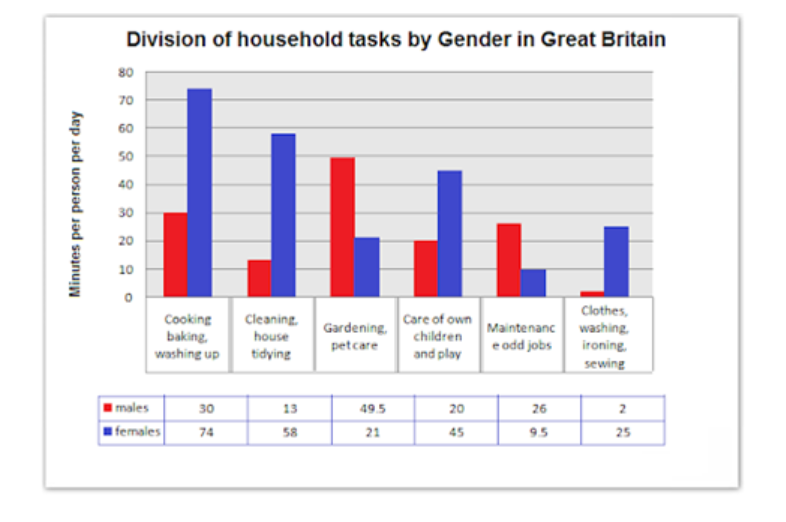
Answer: The chart delineates the gender-specific allocation of household duties in Great Britain, revealing a traditional division of labor. Women dedicate significantly more time to household chores, averaging around four hours daily, which is notably higher than the less than two and a half hours contributed by men.
Women lead in activities such as cooking, cleaning, childcare, and laundry, devoting roughly 200 minutes daily—triple the time men allocate to these tasks. Conversely, men exhibit a preference for outdoor and maintenance work, investing double the time compared to women in activities like gardening and various house repairs.
Interestingly, men’s highest time investment peaks at nearly 50 minutes on gardening and pet care, while women allocate about 30 minutes to these tasks. A stark contrast appears in clothing care: men spend a mere 2 minutes per day on washing, ironing, and sewing, whereas women spend about 25 minutes.
In essence, the chart illustrates a pronounced disparity in the distribution of household responsibilities by gender, with women shouldering the bulk of indoor chores and men tending towards outdoor and maintenance-related tasks.
Q.3 You asked people what they thought was the most valuable thing. The given pie chart shows the analytics of the different answers you received. Write an analytical paragraph for a research project in 150-200 words.
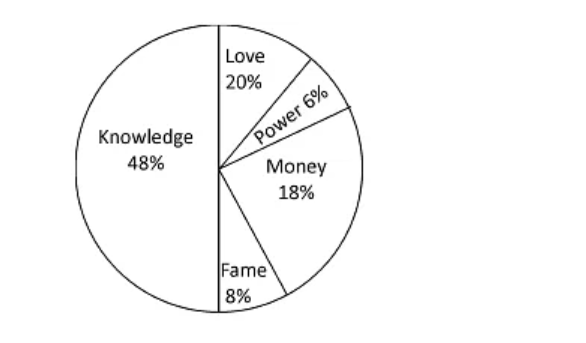
The pie chart in question offers a visual representation of people’s perceptions of what constitutes the most valuable entity in life. This chart is a kaleidoscope of values, sliced into five distinct categories, each representing a different element deemed as most precious by the respondents.
Notably, ‘Knowledge’ emerges as the predominant value, claiming a 48% majority of the chart. This illustrates a significant inclination towards intellectual assets over materialistic or social standings, with nearly half the participants affirming that knowledge surpasses all other forms of value. In stark contrast, ‘Power’ appears to be the least favored, occupying the smallest section, suggesting a minimal number of individuals regard it as the pinnacle of value.
‘Fame’ treads closely behind ‘Power’, indicating a slightly higher but still limited endorsement as a valuable asset. Meanwhile, ‘Love’ and ‘Money’ demonstrate a near equal distribution, capturing 20% and 18% respectively. This balance suggests a common perception that emotional fulfillment and financial security are nearly equally significant, yet fall behind the intellectual prowess represented by ‘Knowledge’.
In essence, the chart paints a picture of a society that places the highest worth on enlightenment and understanding, with ‘Knowledge’ at the vanguard. It indicates a moderate valuation of emotional and monetary fulfillment, while ‘Power’ and ‘Fame’ are perceived as lesser in the hierarchy of values. This data provides an insightful snapshot into the collective mindset, valuing wisdom as the paramount treasure.
Q.4 The given double bar graph shows the preferences of children in a school in playing different games over the span of six years. Write an analytical paragraph about the given information.
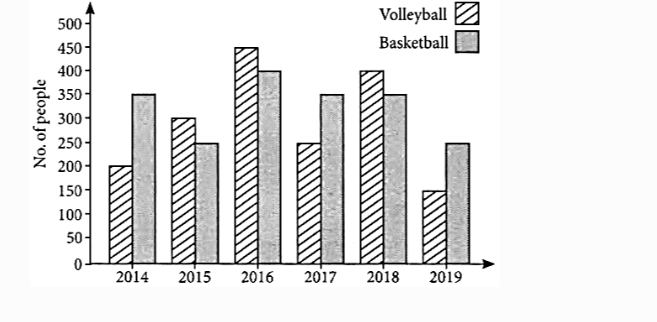
Answer: The double bar graph provides insight into the shifting game preferences among schoolchildren across a six-year span. Volleyball’s popularity peaked in 2016 but notably dipped by 2019. In contrast, basketball maintained a steady interest level throughout the years, with minimal fluctuations. The graph indicates that volleyball saw a dramatic increase in interest in 2016, with a sudden rise in the number of children playing the game, yet this interest did not sustain and saw a drop in subsequent years.
Basketball, on the other hand, displayed remarkable consistency in popularity, with a slight increase in 2016, mirroring volleyball’s peak year, before stabilizing. This consistent preference suggests basketball’s enduring appeal among the children.
In summary, while volleyball experienced more significant highs and lows in popularity, basketball remained a constant favorite throughout the six years. The data suggests that despite volleyball’s brief surge in popularity, basketball was the more consistently chosen sport among the schoolchildren by the end of the six-year period.
Q.5 The given pie chart represents the amount of money spent by a family on different items in a month. Write an analytical paragraph using the information given in the chart.
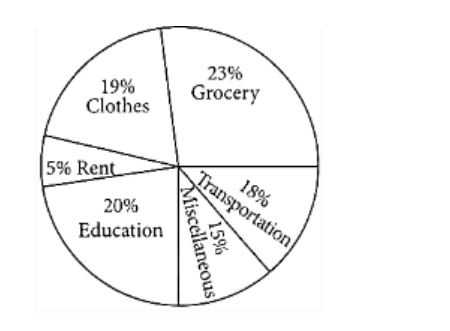
Answer: The pie chart in question details the monthly expenditure pattern of a family, highlighting their financial priorities and spending habits. The chart indicates that groceries constitute the largest expense at 23%, underscoring the family’s emphasis on home-cooked meals and the importance of nutrition. Education follows close behind at 20%, reflecting the family’s commitment to learning and academic growth.
Clothing and transport are also significant expenses, accounting for 19% and 18% respectively, which suggests a balance between necessity and personal care. Meanwhile, 15% of the budget is allocated to assorted items, possibly encompassing leisure and lifestyle products like stationery and cosmetics. Interestingly, the least portion of their budget goes towards rent, which may imply a strategic decision to minimize fixed living costs.
In essence, the family’s budgeting choices show a strong inclination towards essential spending, with most of their outgoings directed at fundamental needs and responsibilities. The limited expenditure on miscellaneous items hints at prudent financial management, with the majority of the budget being conscientiously allocated to areas that support their sustenance, education, and mobility. This careful allocation suggests a disciplined approach to budgeting, with discretionary spending kept to a minimum in favor of essential expenses and long-term investments in education.
Common Mistakes in Analytical Paragraph Writing
When writing an analytical paragraph, especially in subjects like English for Class 9 or Class 10, students often make a few common mistakes that can impact the quality of their work. These mistakes can be avoided with careful attention to detail. Here are some of the most frequent issues:
- Failing to Describe the Data Accurately: In analytical paragraph writing, especially for Class 9 or Class 10, it is essential to describe the data clearly and accurately. Misinterpreting graphs, charts, or tables can result in wrong conclusions. Students should focus on presenting the data without adding personal opinions or exaggerating any details.
- Using Complex Language Unnecessarily: Many students tend to use overly complex vocabulary or technical terms in their analytical paragraphs. While it’s important to use good language skills, simplicity is the key. Using clear and straightforward language makes the analysis more effective. For example, instead of saying “ascertain the primary trend,” simply writing “identify the main trend” makes it clearer.
- Not Maintaining the Same Tense Throughout the Paragraph: Consistency in tense is vital when writing an analytical paragraph. In Class 10, students should make sure they use the same tense throughout. Switching between past, present, and future tenses can confuse the reader and disturb the flow of the analysis.
- Lack of Proper Structure: A clear structure is crucial for an effective analytical paragraph. Students should follow the analytical paragraph format, starting with an introduction, followed by an analysis of the data, and ending with a conclusion. Without this structure, the paragraph may become disorganized and difficult to understand.
- Overcomplicating the Explanation: When writing an analytical paragraph, focus only on the most important points. Avoid overloading the reader with unnecessary details. Stick to the main aspects of the data and keep the explanation concise and clear.
Tips for Writing an Analytical Paragraph
- Understand What an Analytical Paragraph Is: Before you start writing, know that an analytical paragraph involves breaking down a topic and explaining its elements clearly.
- Follow Format: If you are working on a class 10 analytical paragraph, stick to the analytical paragraph class 10 format. This format usually includes an introduction, body, and conclusion.
- Use Examples for Guidance: Look at analytical paragraph class 10 solved examples or analytical paragraph class 10 solved examples pdf to get a feel for how to structure your writing.
- Choose Your Topic Wisely: Whether it’s an analytical paragraph on a bar graph or any other topic, pick something you can break down into manageable parts.
- Start with a Clear Thesis Statement: In analytical paragraph writing, your first sentence should clearly state what you’ll analyze.
- Support Your Analysis with Evidence: Use examples from the text, graph, or data you’re analyzing. This is especially important in analytical paragraph class 10 CBSE syllabus.
- Organize Your Paragraph Well: Stick to the analytical paragraph format. Each part of your analysis should flow logically into the next.
- Practice with Different Topics: Try writing an analytical paragraph class 8 or analytical paragraph class 9 level before advancing to more complex topics.
- Use Worksheets and Practice Questions: Utilize resources like analytical paragraph class 10 worksheet and analytical paragraph class 10 questions to hone your skills.
- Seek Feedback and Improve: After writing, compare your work with analytical paragraph solved examples or ask a teacher to review it.
Remember, effective analytical paragraph writing involves clear expression of ideas and structured analysis. Practice regularly, and refer to various examples of analytical paragraph to improve your skills.
FAQs on Analytical Paragraph
What is an analytical paragraph?
An analytical paragraph is a type of writing that examines and interprets an issue, event, or situation. It presents a focused analysis using evidence, reasoning, and examples to support the writer's opinion or viewpoint.
Is heading important in analytical paragraph class 10?
While headings are not mandatory for analytical paragraphs, they can be helpful in summarizing the topic or the main idea of the paragraph. In Class 10 exams, the focus is on clear, structured writing, so a heading may not always be required unless specified by the exam instructions.
What is analyzing paragraph writing?
Analyzing paragraph writing involves breaking down a topic, event, or subject into its components, examining each part critically, and presenting a detailed interpretation or explanation of how the components fit together. It requires reasoning and supporting details.
How to write an analytical paragraph in class 10?
To write an analytical paragraph in Class 10:
- Start with a topic sentence that clearly states the point or analysis.
- Provide evidence or examples to support your analysis.
- Use explanation to clarify how the evidence supports the point.
- Conclude with a concluding sentence that reinforces the analysis.
What is pie chart in CBSE Class 10?
A pie chart in CBSE Class 10 is a circular graph that is divided into slices to illustrate numerical proportions or percentages of a whole. Each slice represents a category's contribution to the total.
What is the format of analytical writing?
The format of analytical writing generally includes:
- Introduction: A clear statement of the topic or argument.
- Body: In-depth analysis with evidence, examples, and explanation.
- Conclusion: A summary or a closing statement that restates the key points of the analysis.
What is the format to write an analytical paragraph?
The format of an analytical paragraph includes:
- Topic Sentence: Clearly states the main point of the analysis.
- Supporting Details: Evidence, facts, or examples that back up the point.
- Explanation: A detailed interpretation of how the evidence supports the topic.
- Conclusion: Summarize the analysis or provide a final thought.
How do you format an analysis paragraph?
To format an analysis paragraph:
- Start with a clear topic sentence that outlines the subject of analysis.
- Provide evidence or examples to back up your analysis.
- Explain how the evidence supports your argument.
- Conclude by summarizing the main points of your analysis.
How to write a paragraph in class 10?
To write a paragraph in Class 10:
- Begin with a topic sentence.
- Follow up with supporting sentences that elaborate on the topic.
- Use clear and coherent language.
- Conclude with a closing sentence that wraps up the idea of the paragraph.
What is an analytical paragraph?
An analytical paragraph breaks down a topic into parts, explains each part with evidence, and shows how they connect to the overall theme.
How do you write an analytical passage?
To write an analytical passage, start with a clear thesis, then provide evidence or examples for each point, and conclude by linking everything back to your main argument.
How can I get full marks in an analytical paragraph for Class 10?
For full marks in a class 10 analytical paragraph, follow the format, use clear and concise language, back your points with solid evidence, and ensure your paragraph flows well.
How to write an analytical paragraph for Class 10?
In class 10, write an analytical paragraph by stating your main idea, using examples from the text or data for support, and concluding by tying your analysis back to the main point.
What is an analytical paragraph for CBSE Class 10?
An analytical paragraph for CBSE class 10 involves examining a topic in detail, using evidence to analyze each part, and presenting it in a structured and clear format.
What words should be used in an analytical paragraph?
Use clear, precise words in an analytical paragraph. Keywords related to your topic, along with analytical terms like 'evidence', 'analysis', and 'conclusion' are helpful.
How do you write an analytical paragraph for Class 8?
To write an analytical paragraph in class 8, start with a topic sentence, provide details and examples to analyze your topic, and conclude by summarizing your analysis.
What are the 5 parts of an analytical paragraph?
An analytical paragraph consists of an introduction, evidence and analysis, explanation, conclusion, and a clear topic sentence. These parts help structure and convey your analysis effectively.
How do you write a good analytical paragraph in English?
To write a good analytical paragraph in English, start with a clear topic sentence, provide evidence to support your analysis, explain how the evidence relates to your topic, and conclude by summarizing your analysis effectively. Stick to the format and use clear language.









